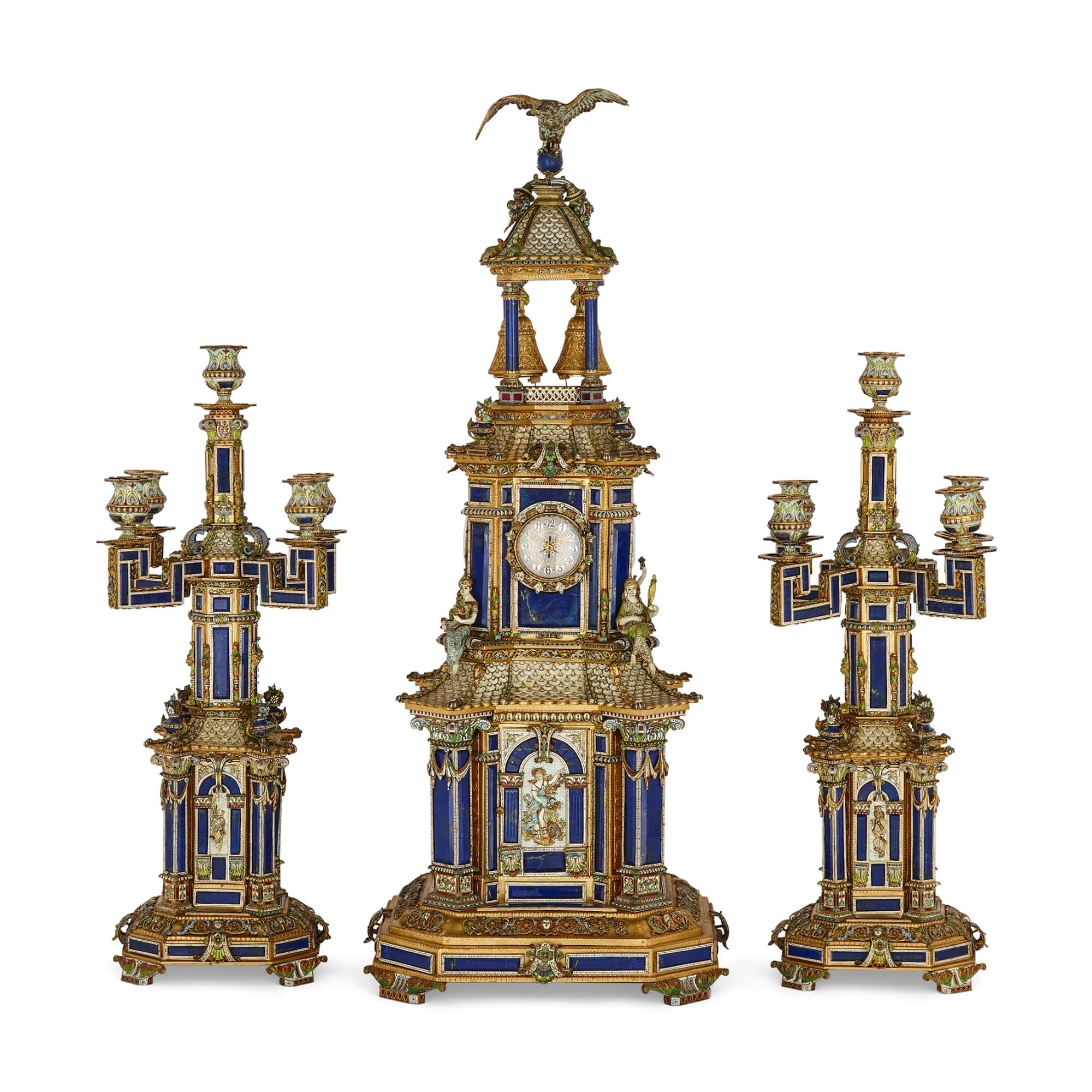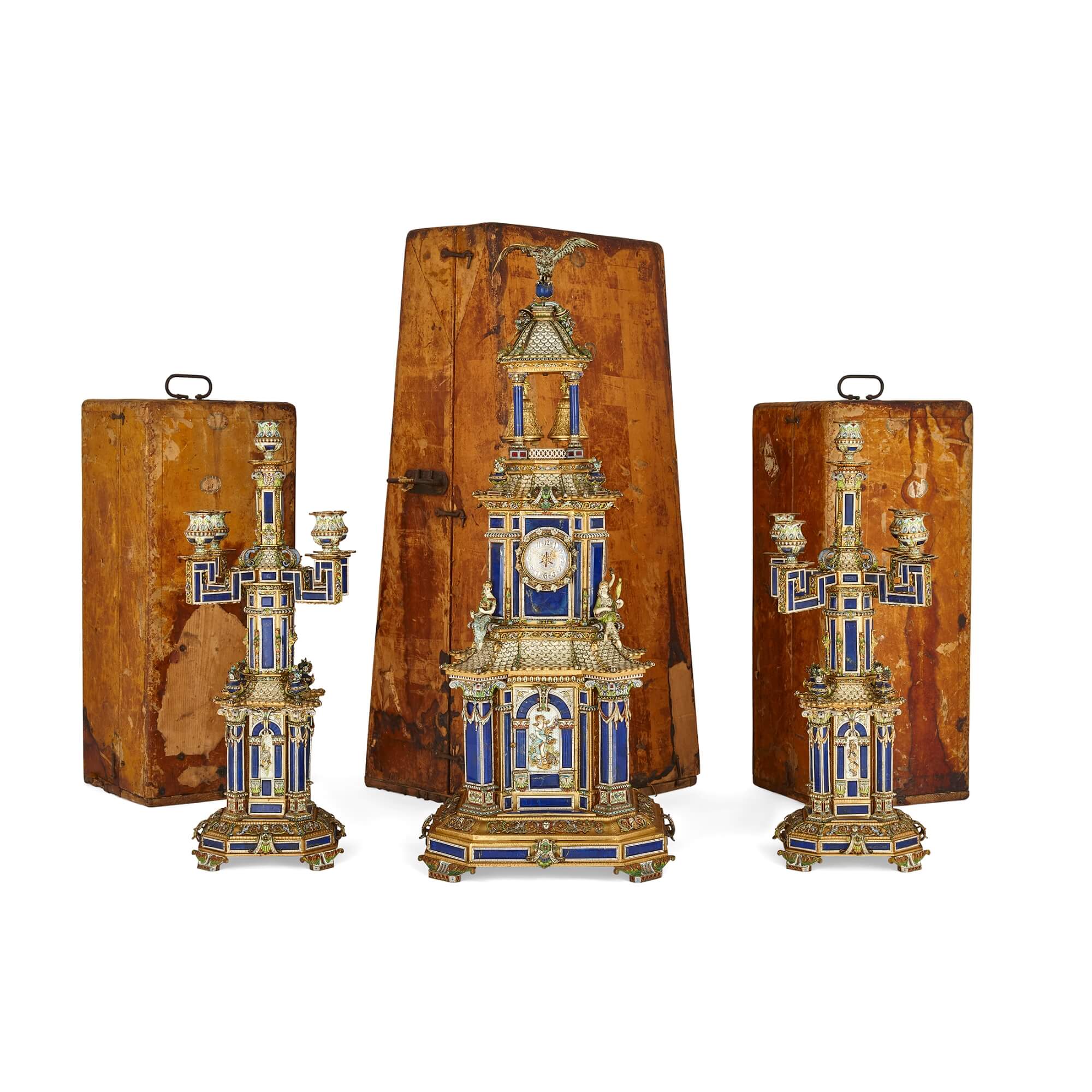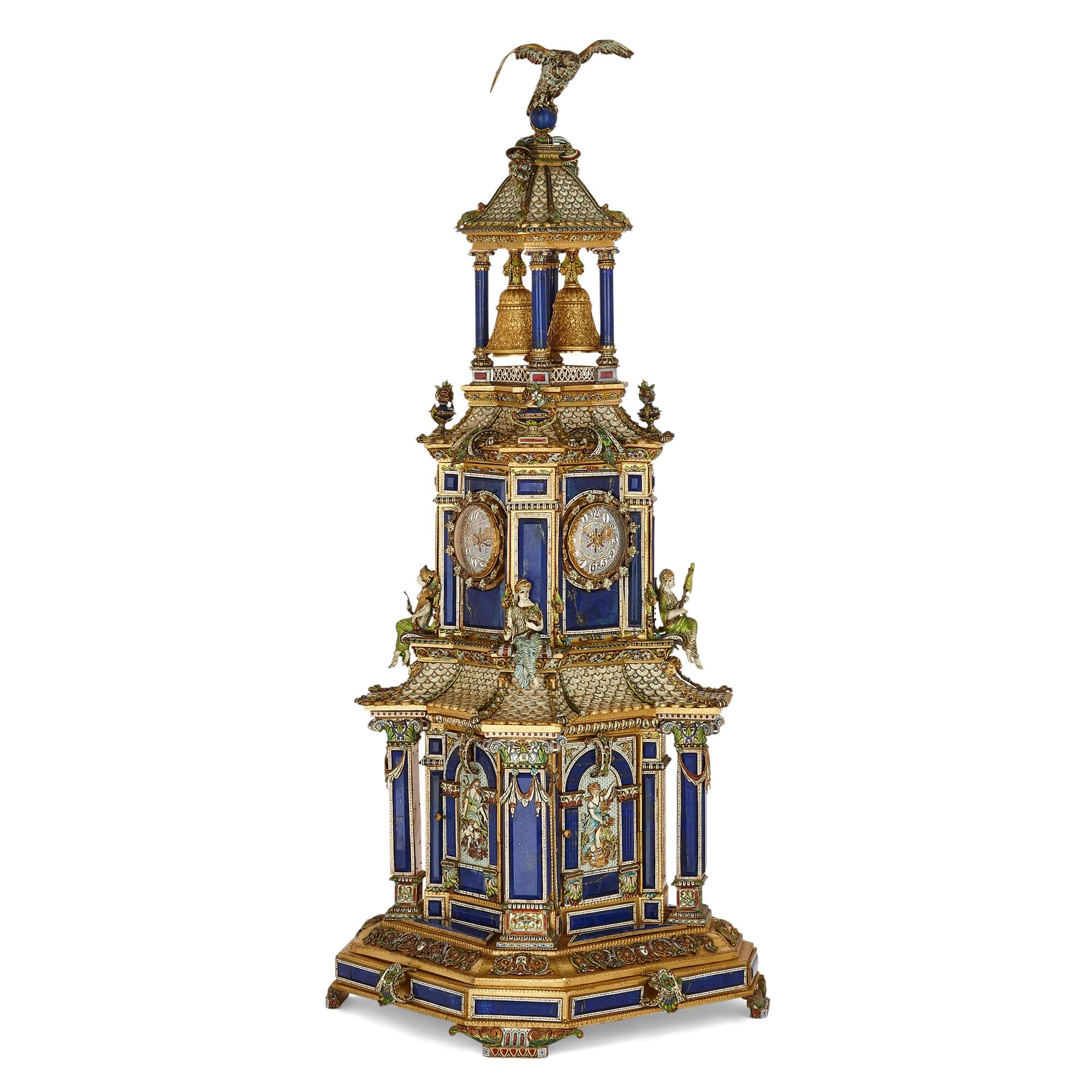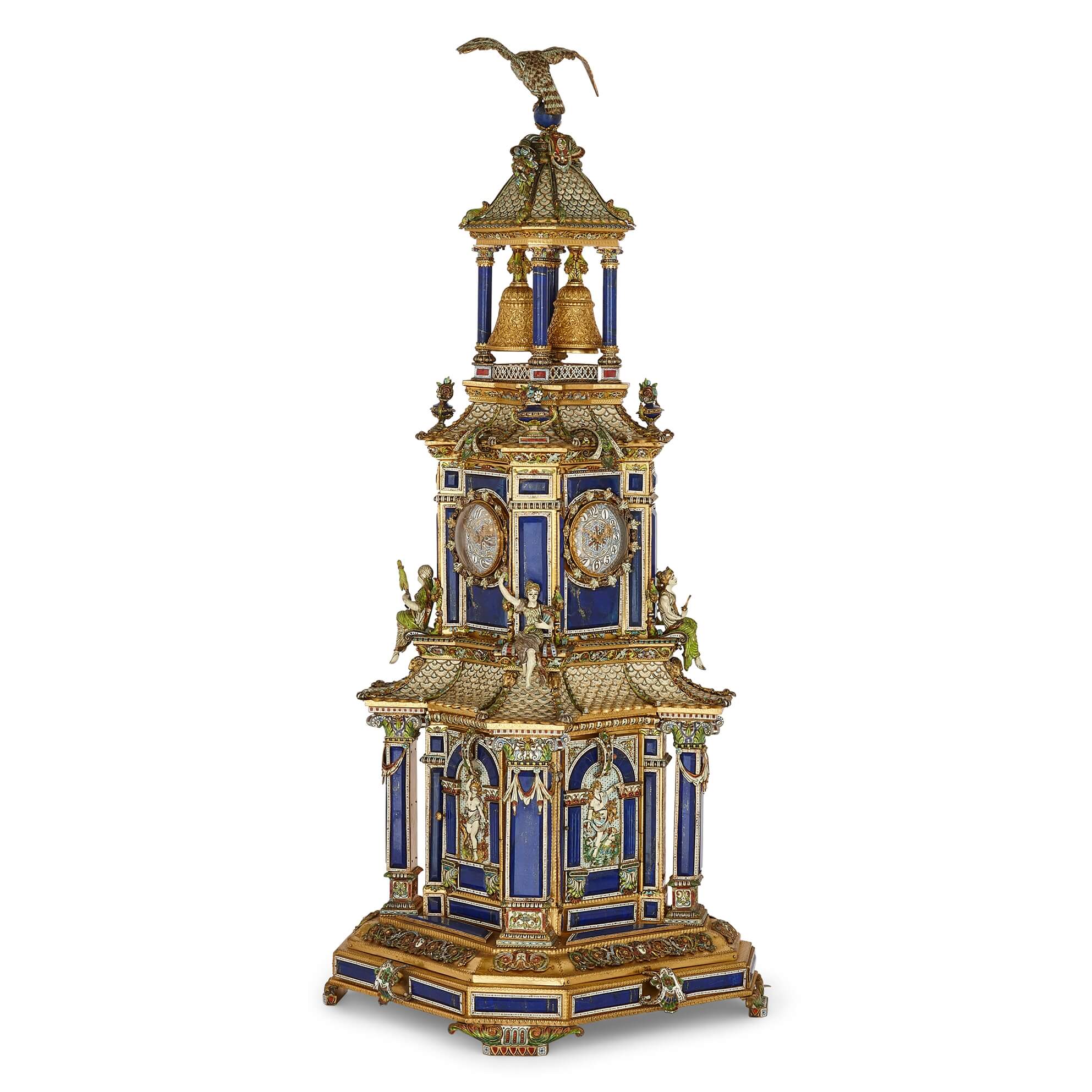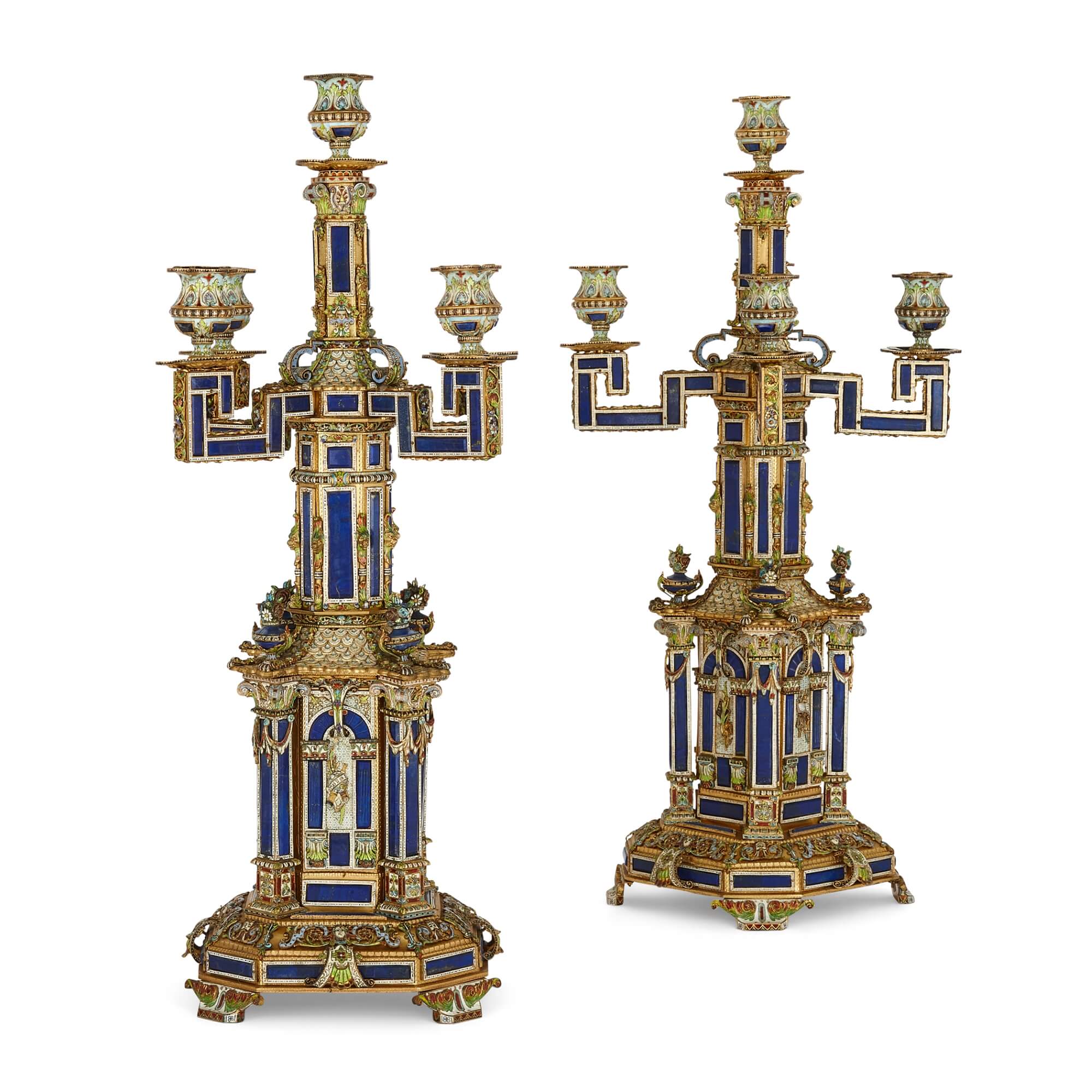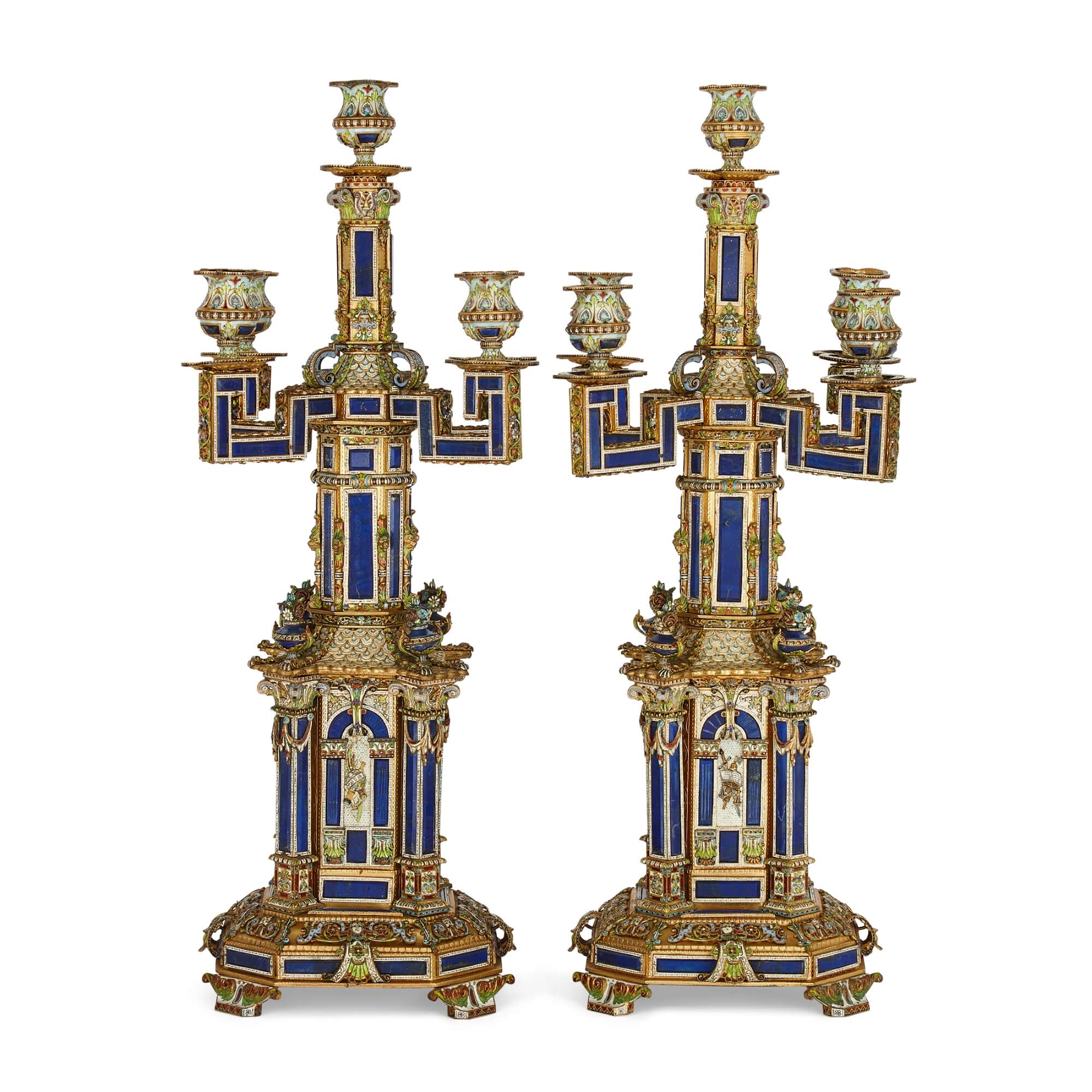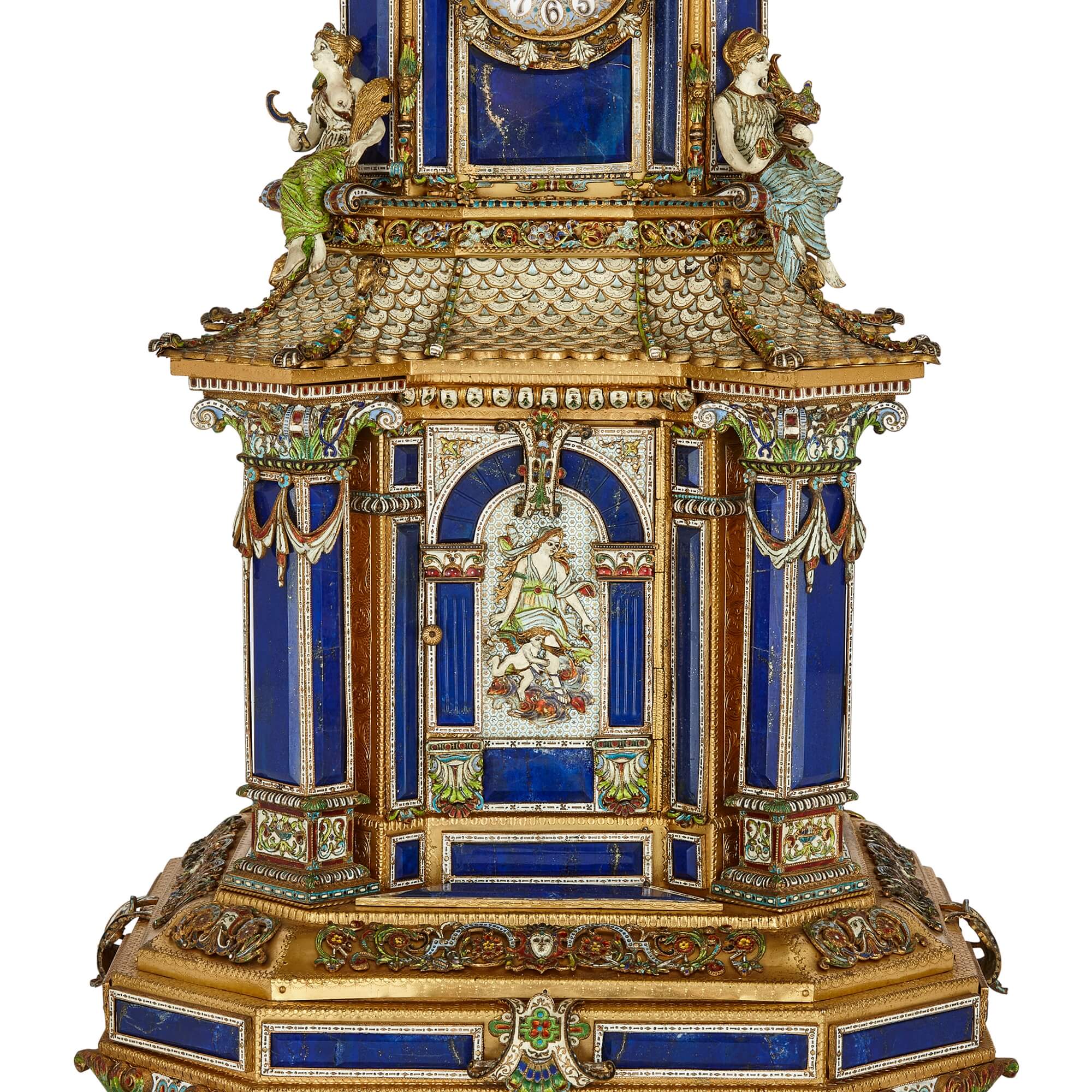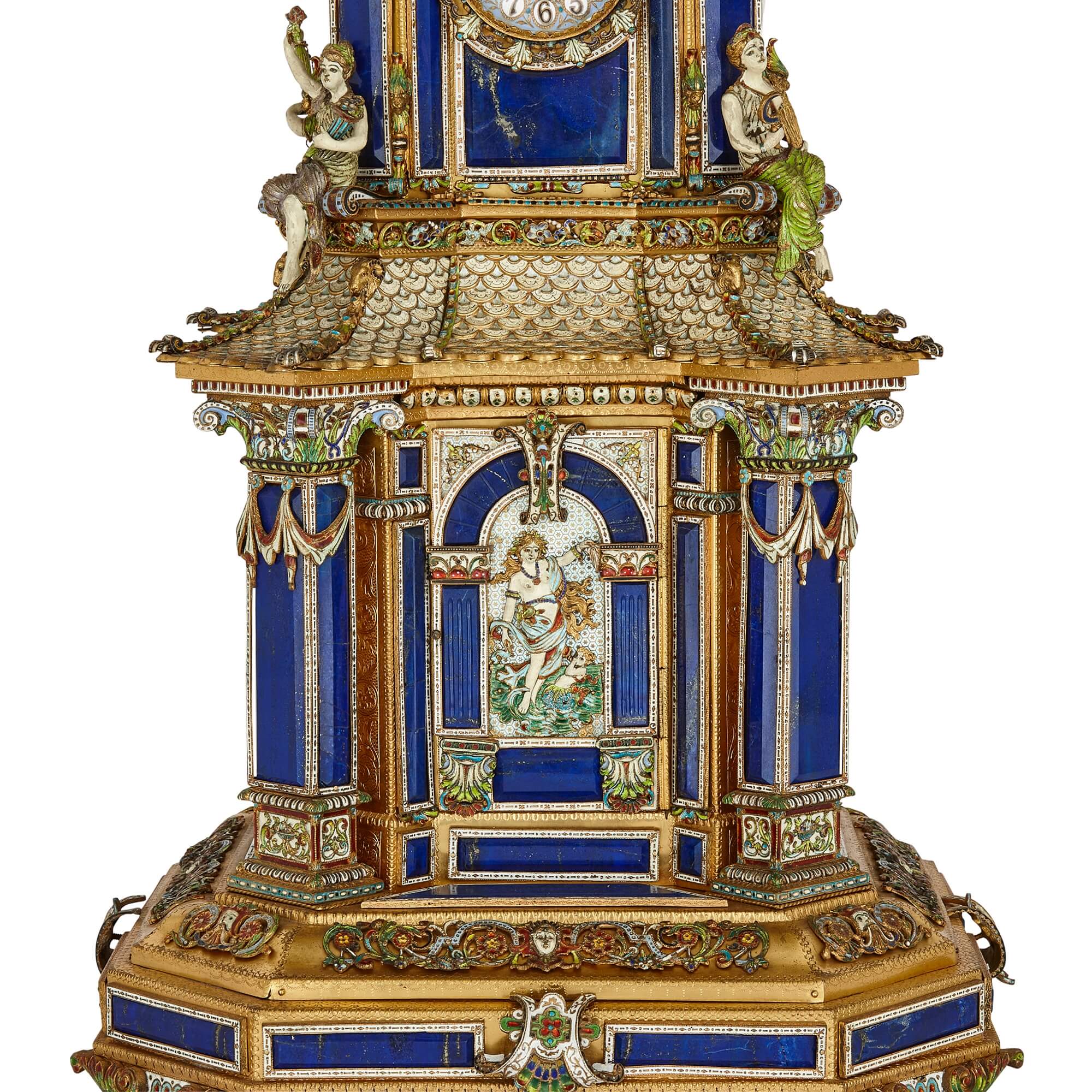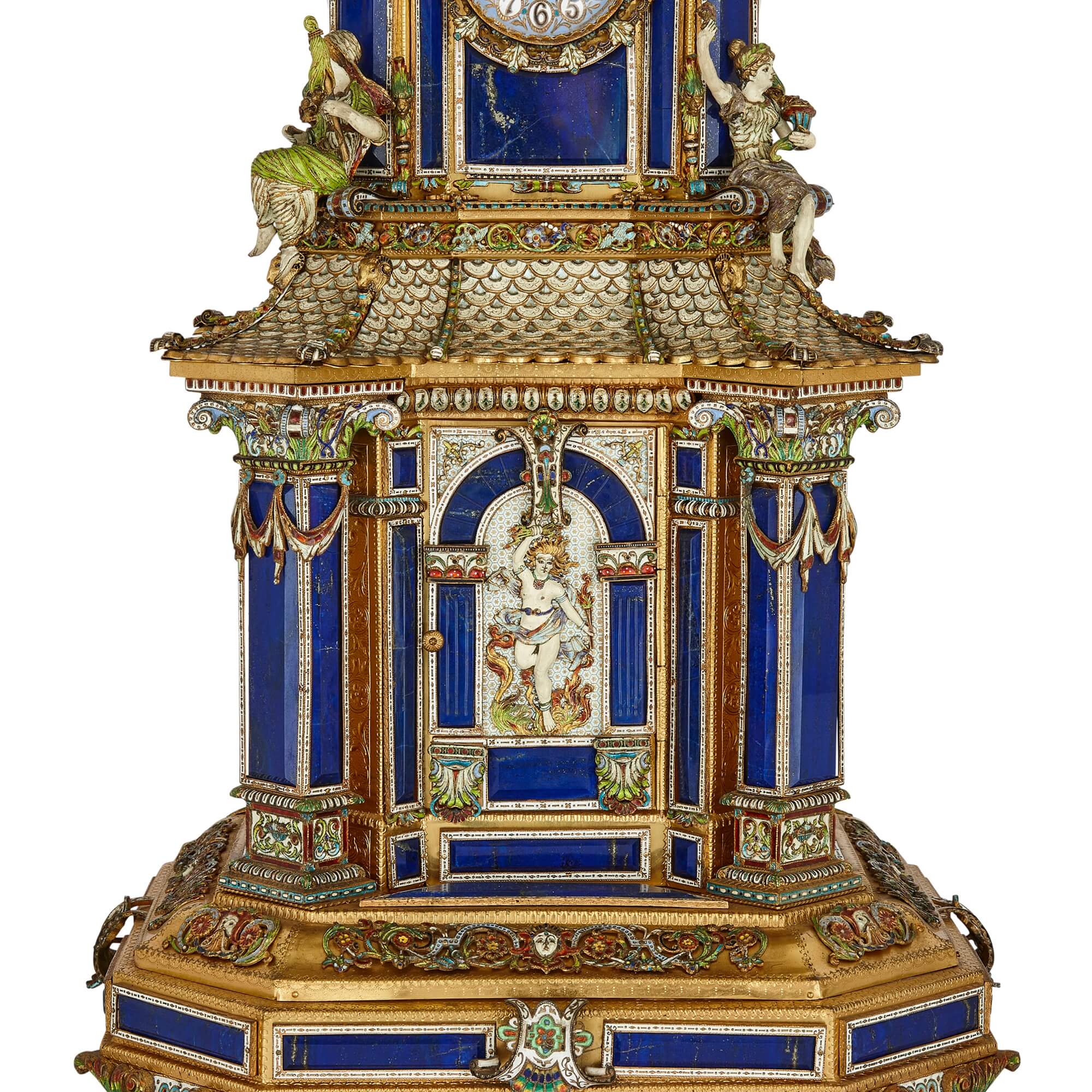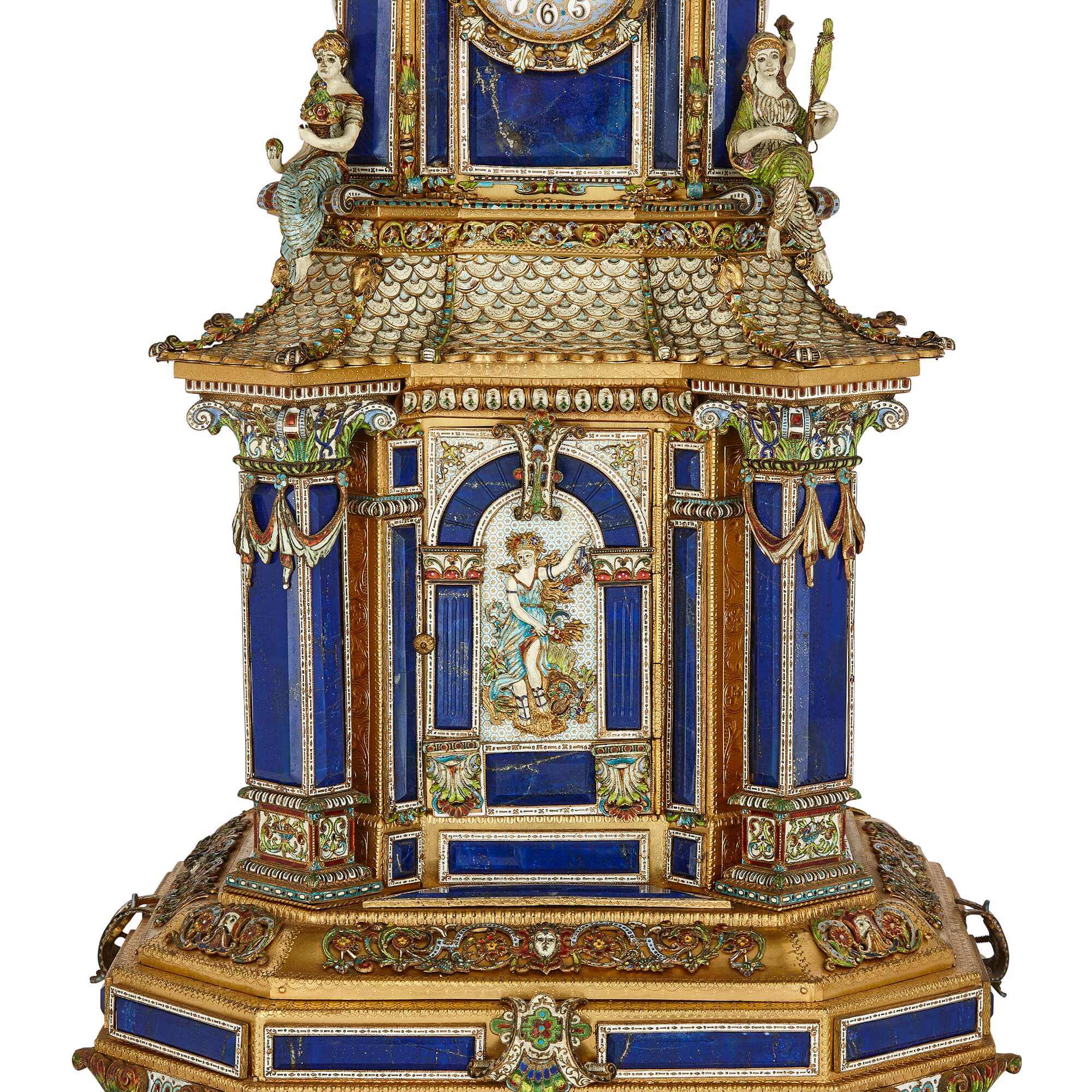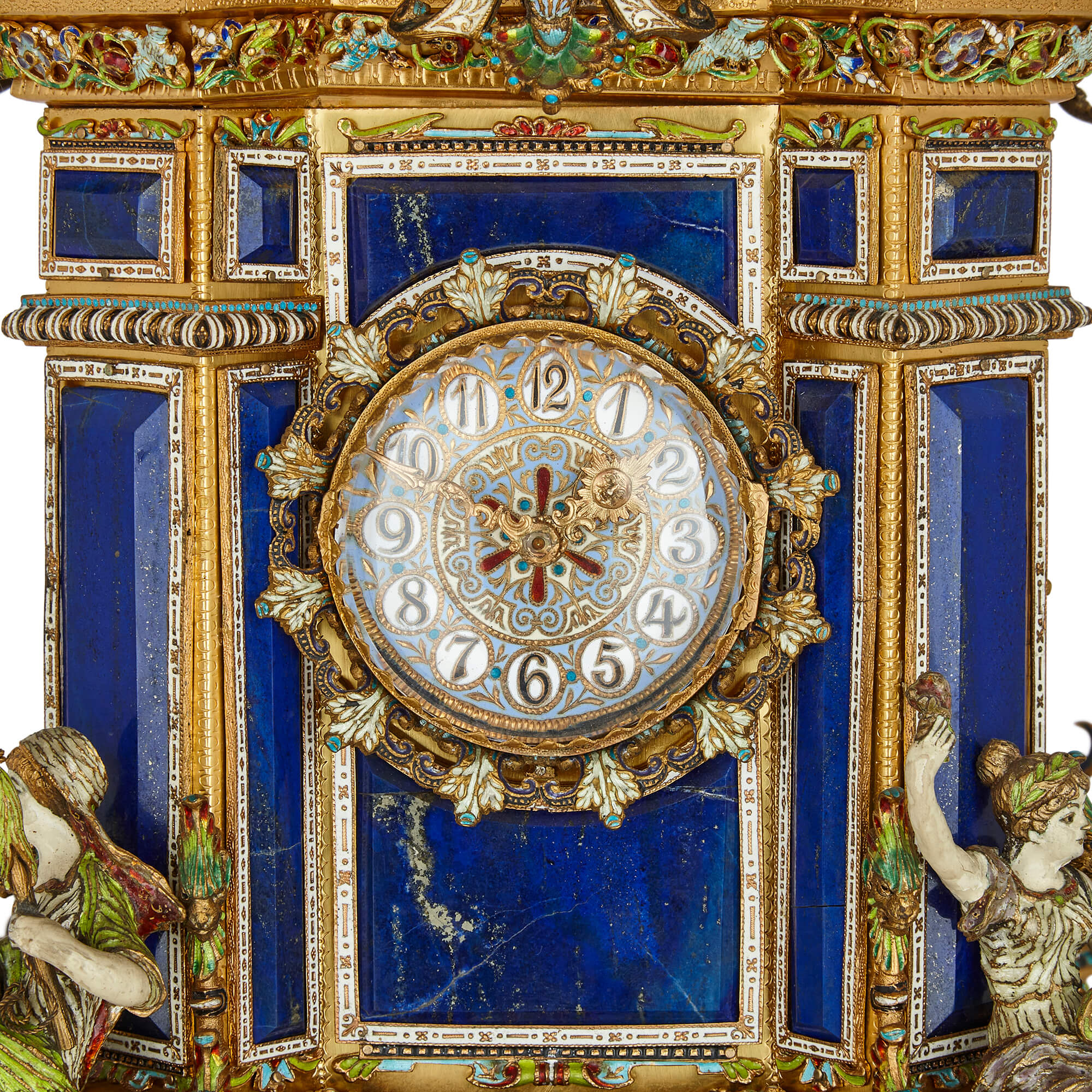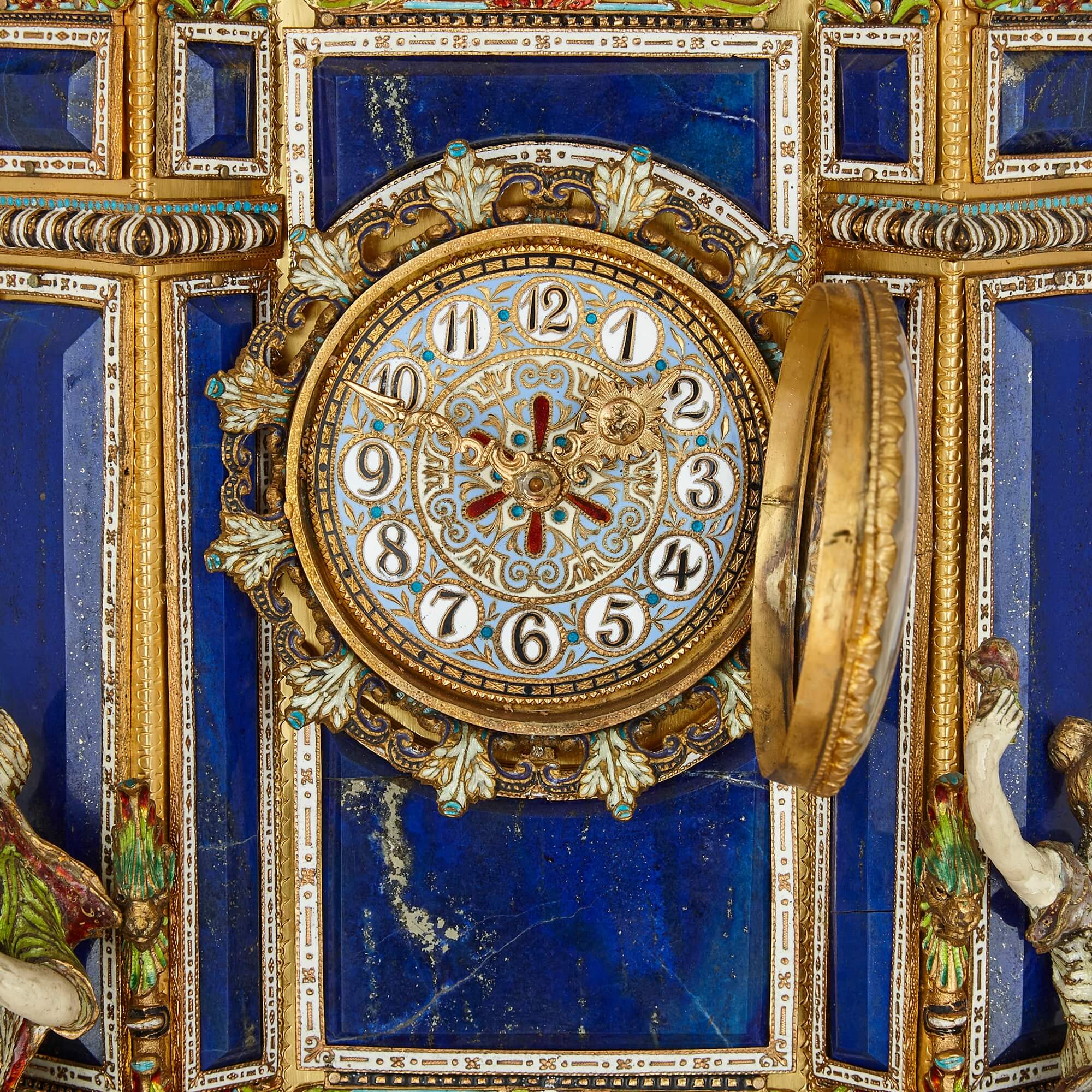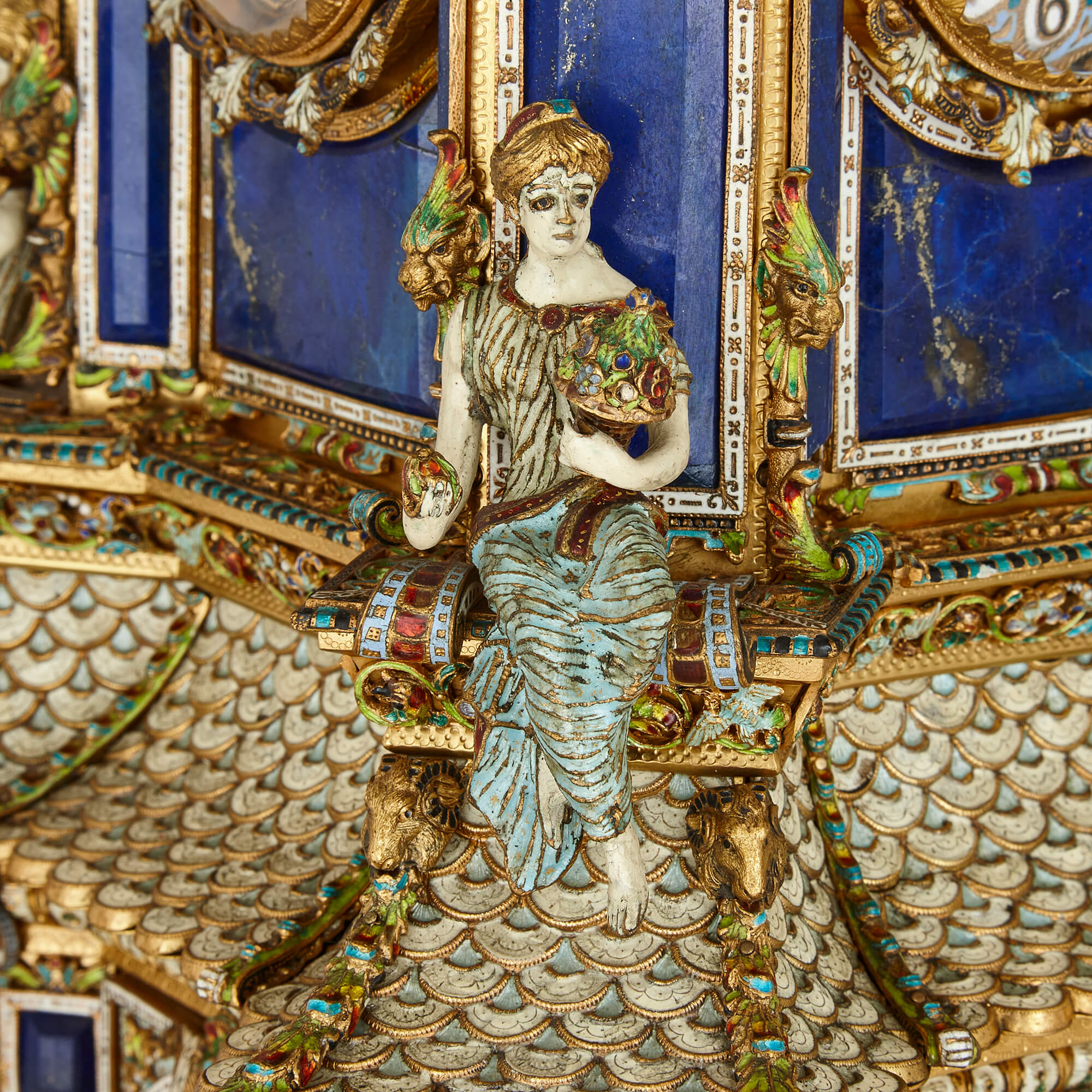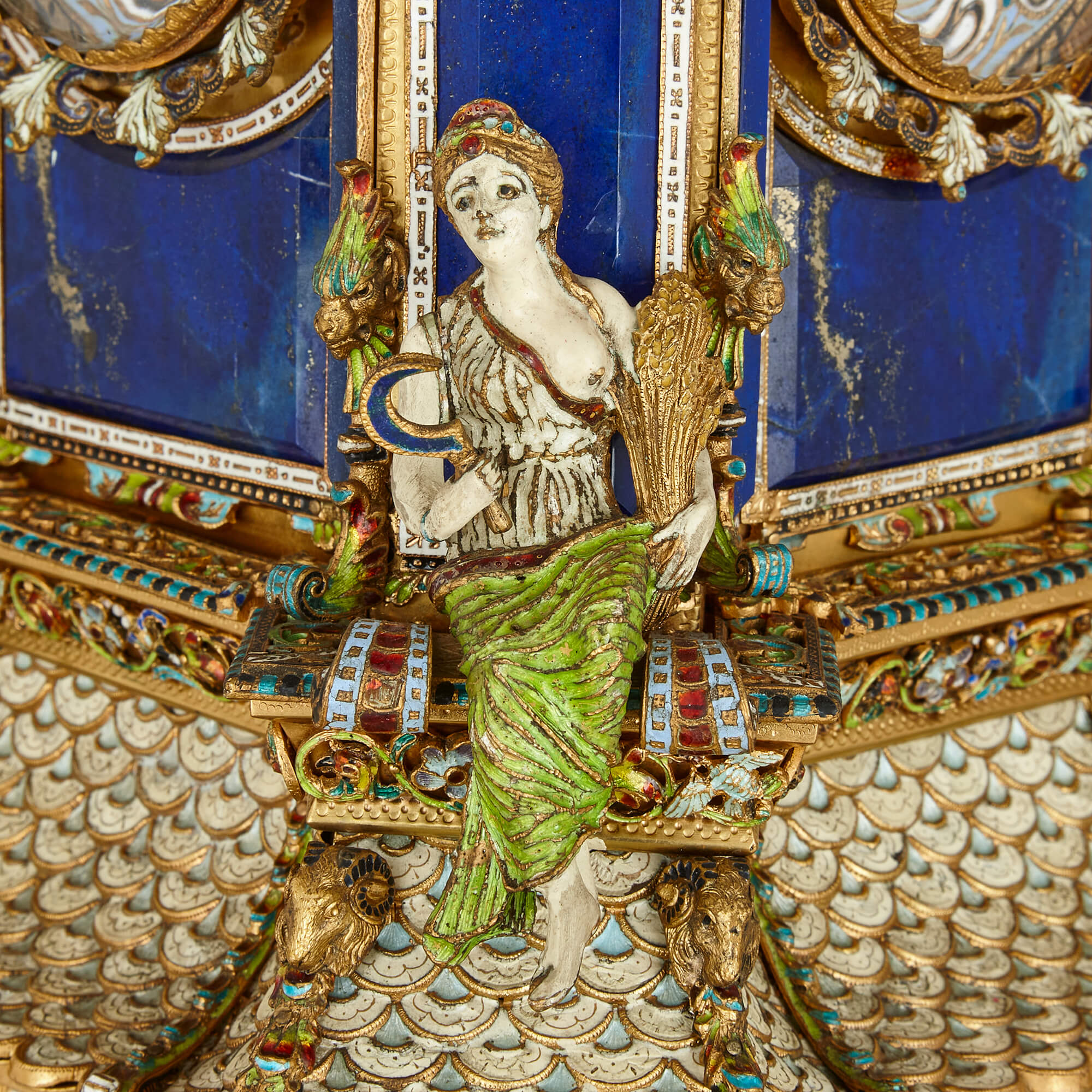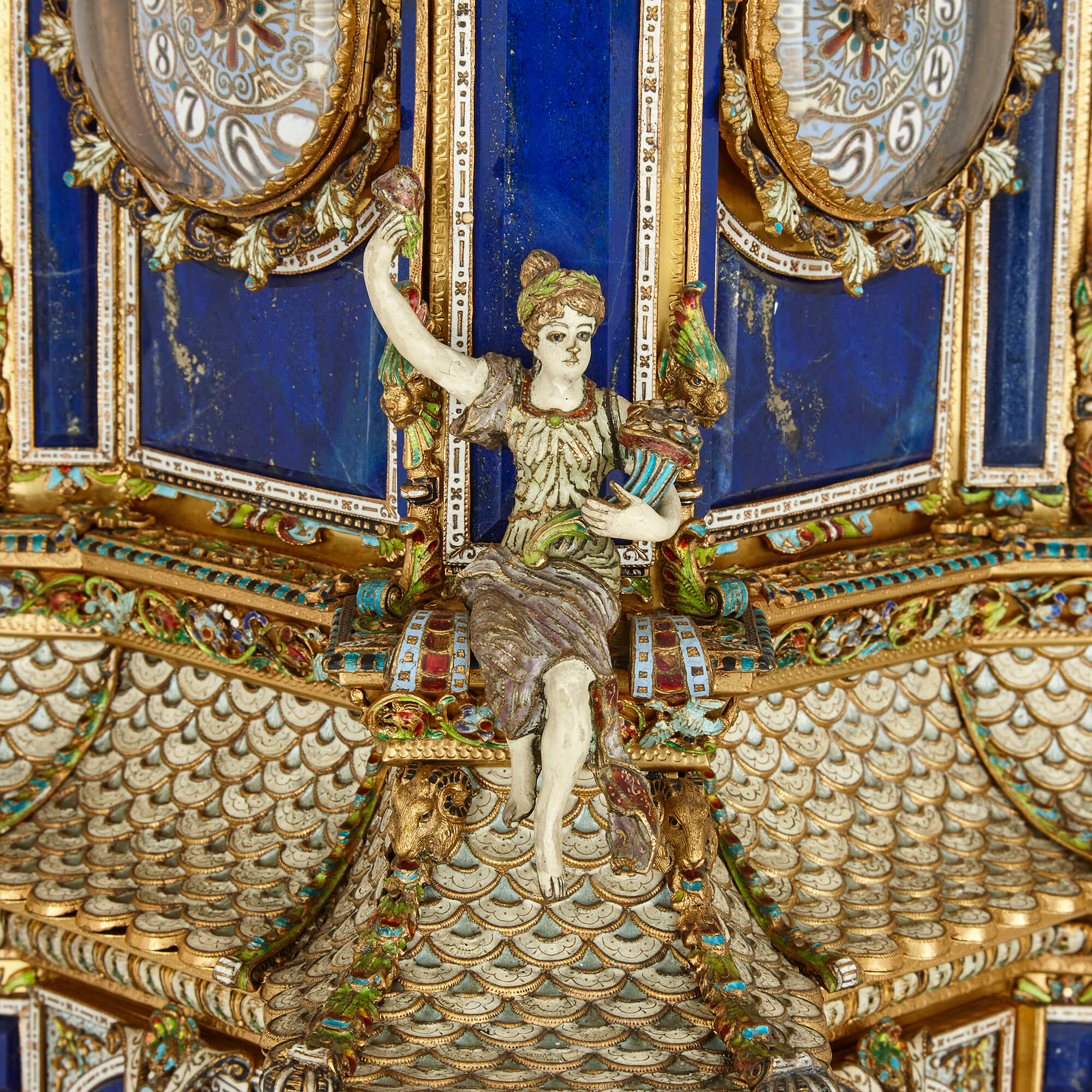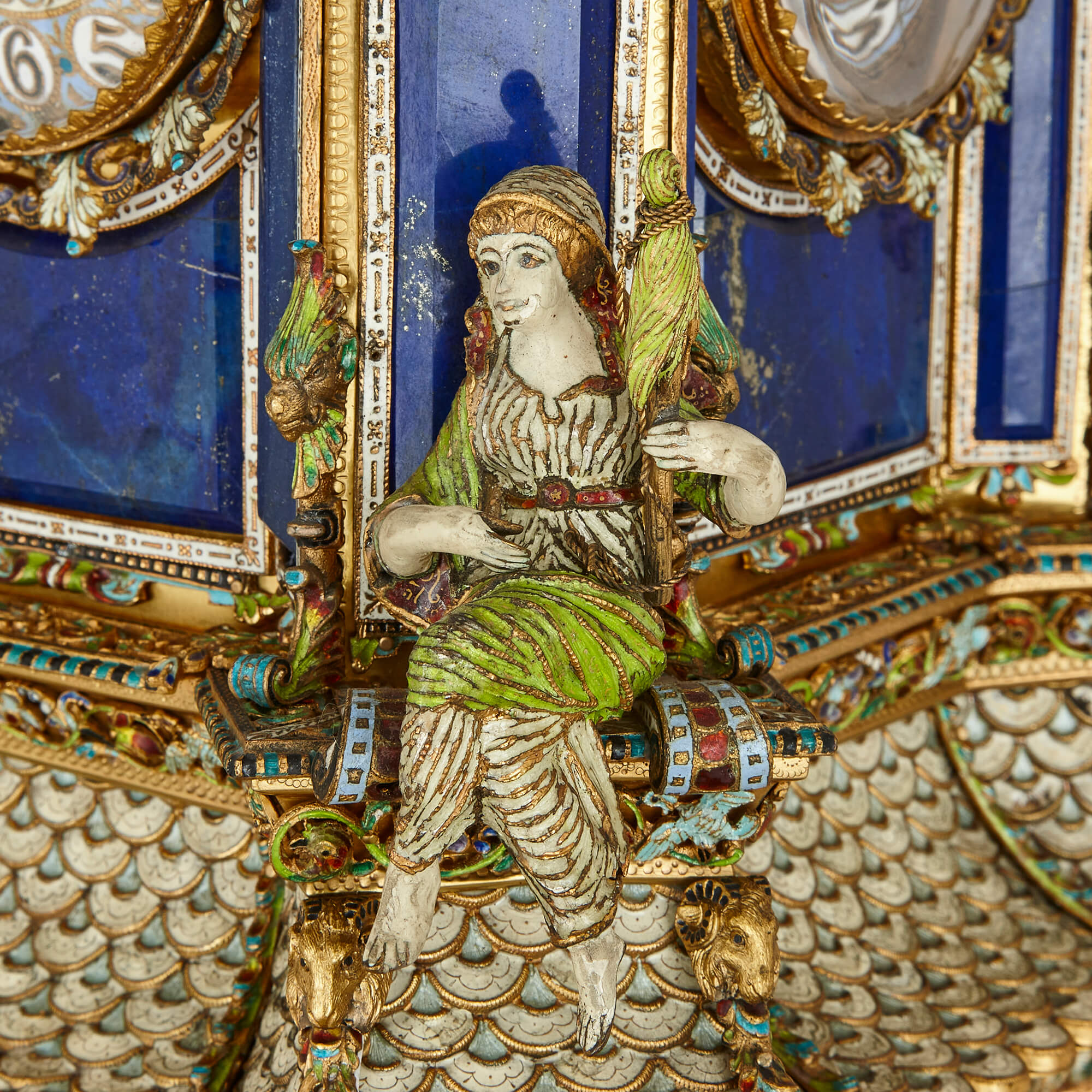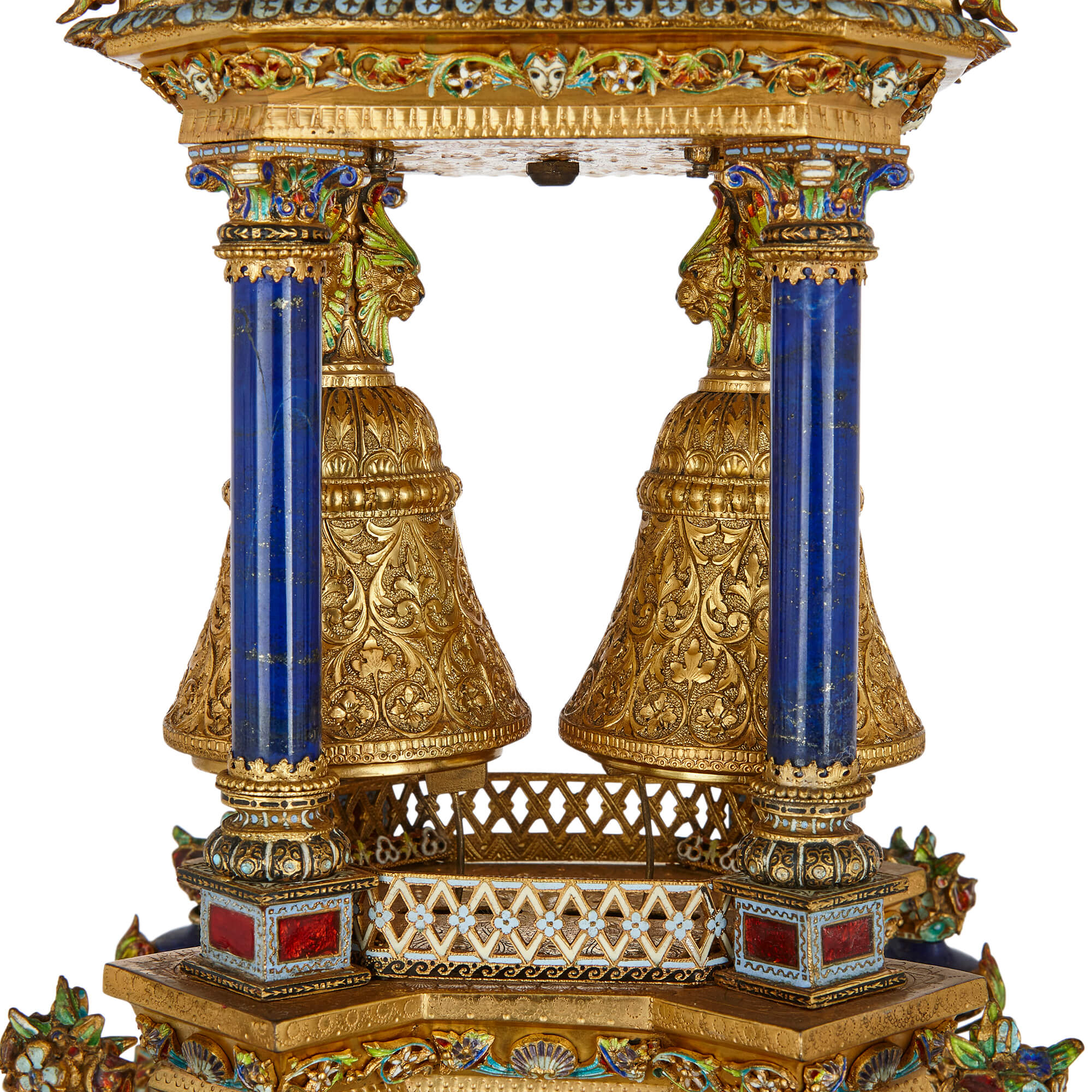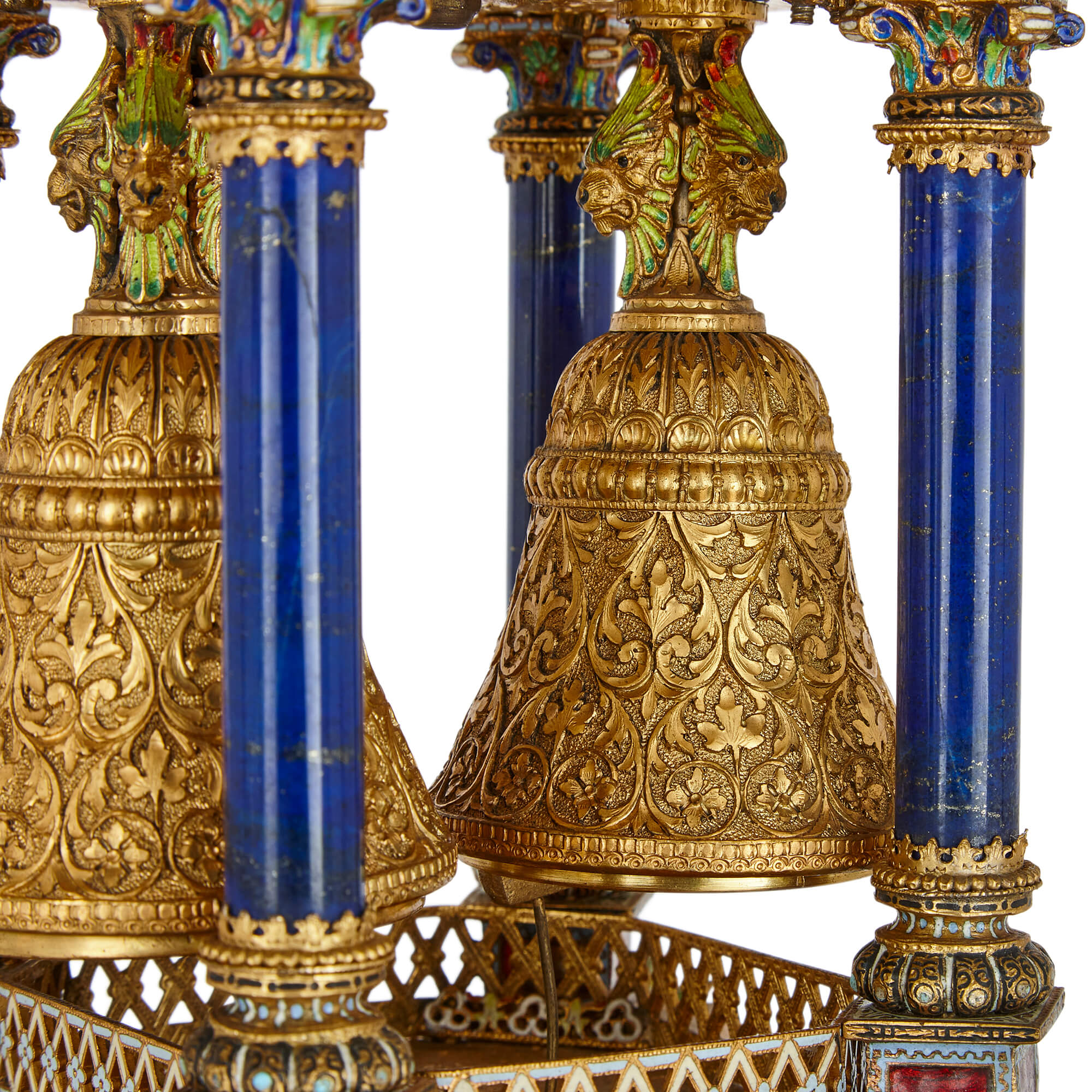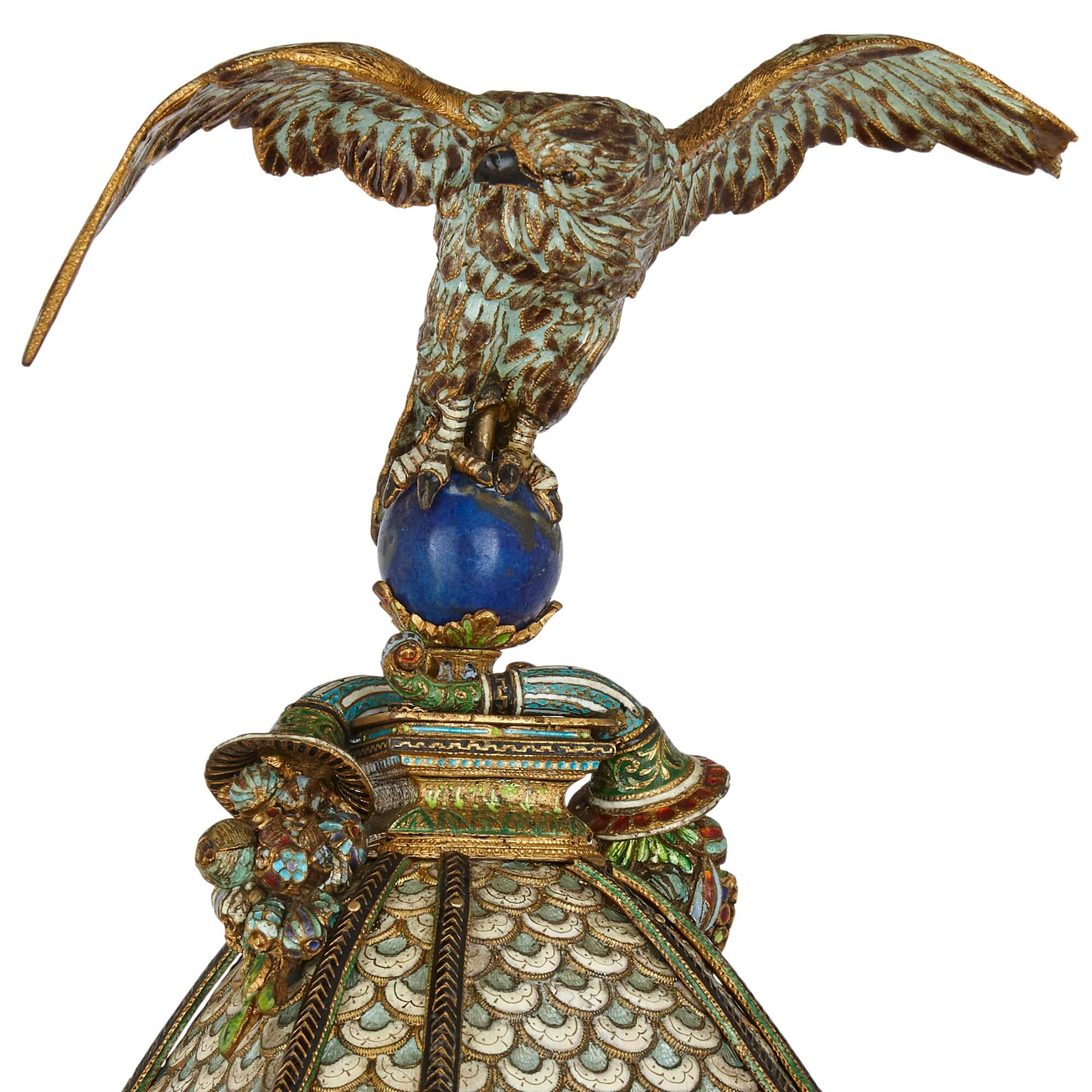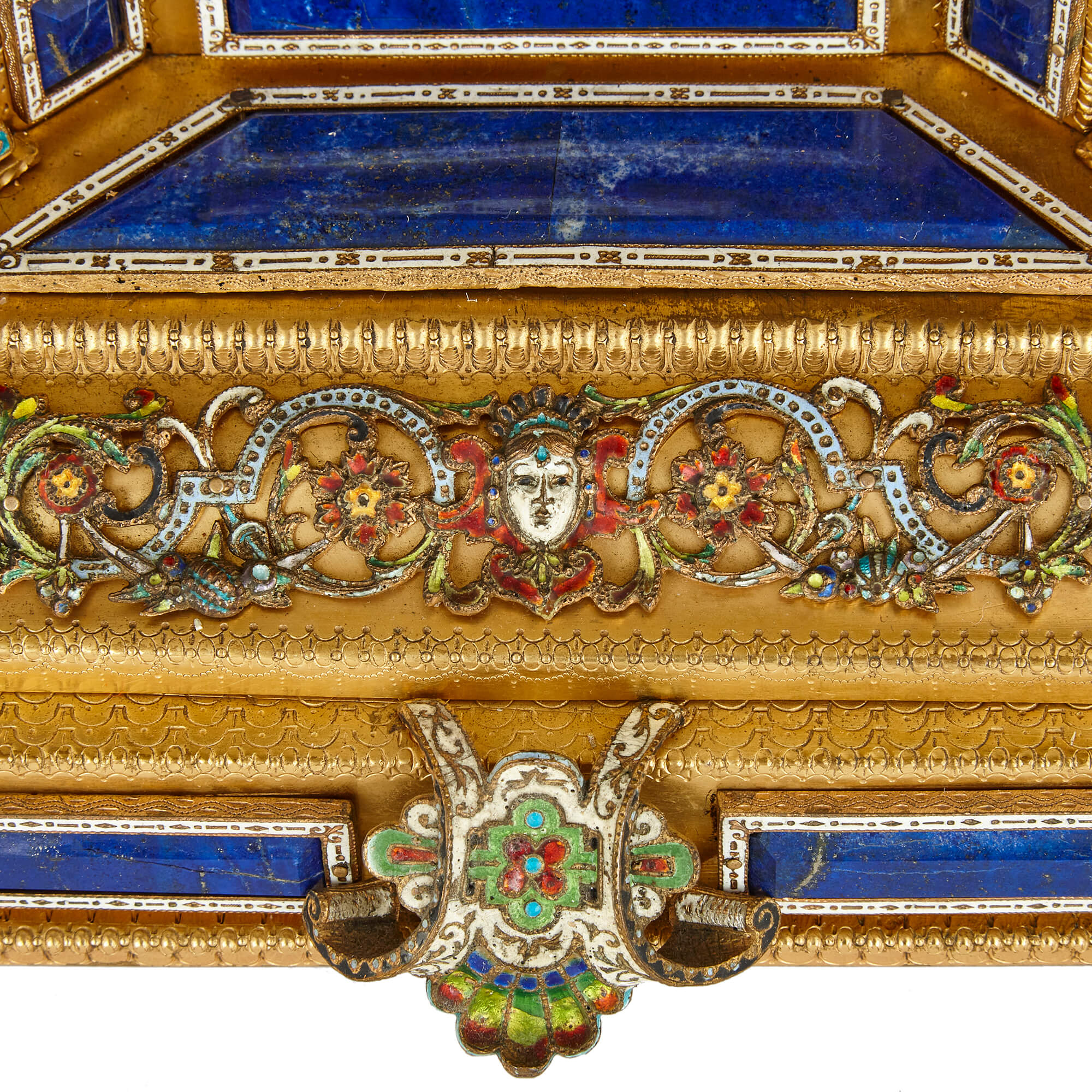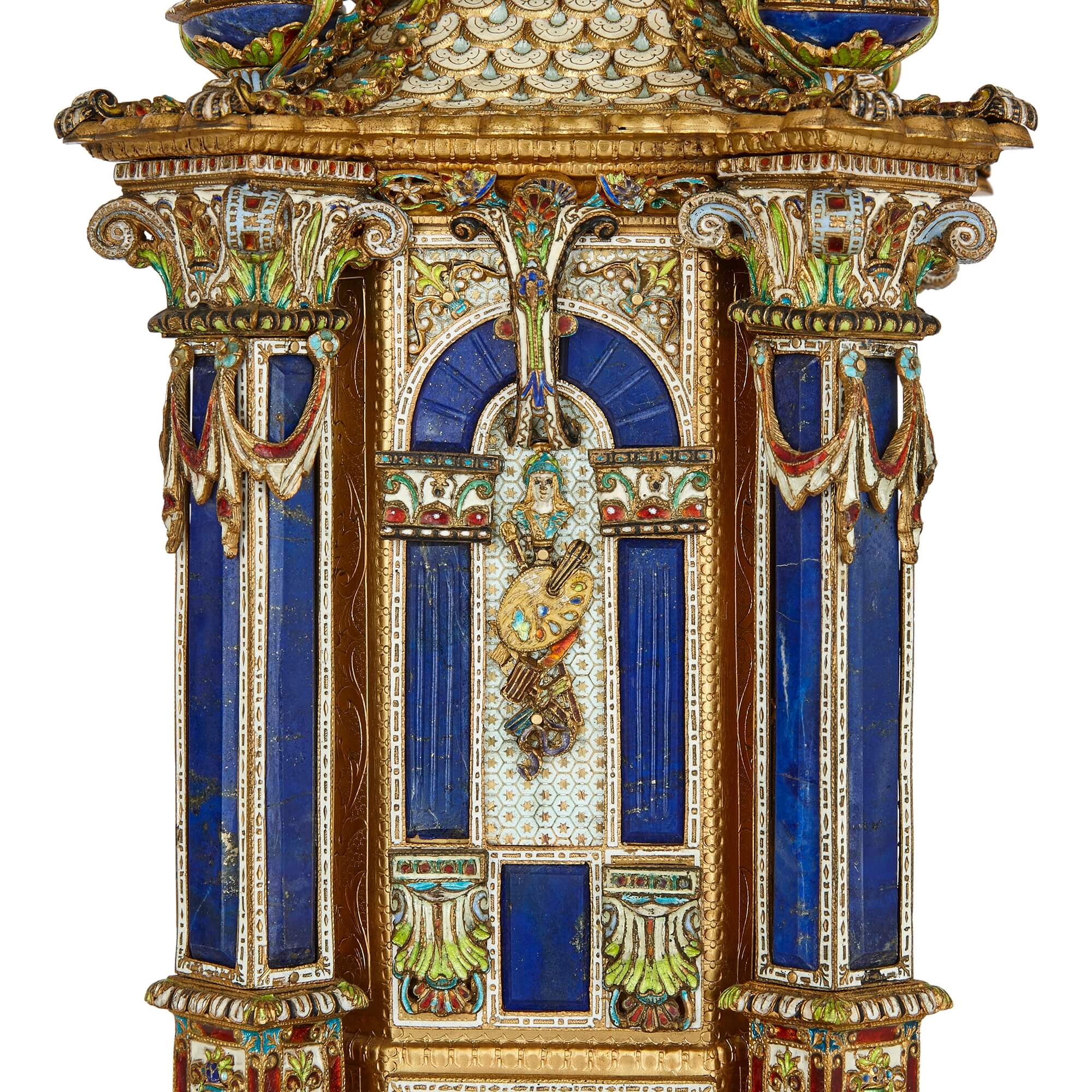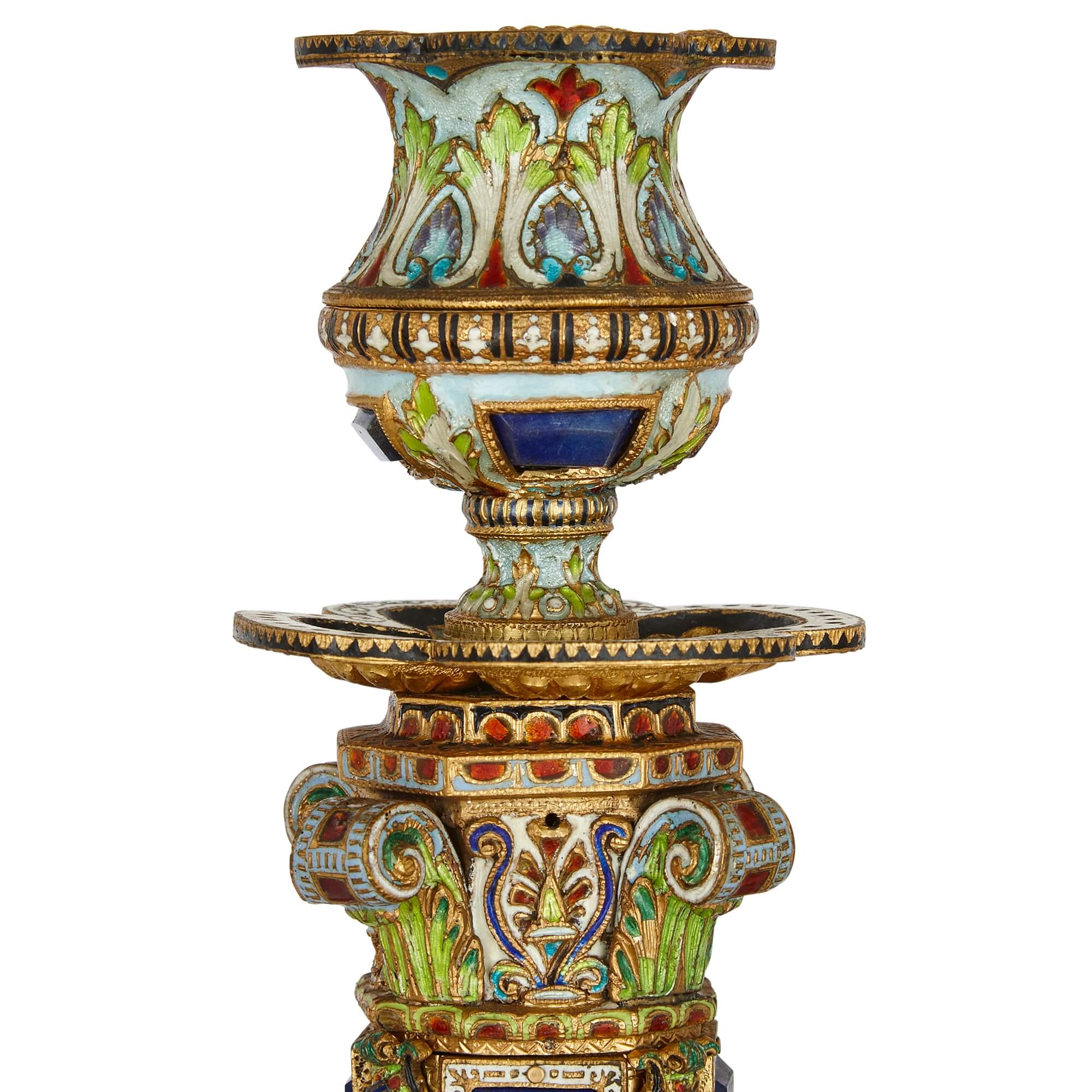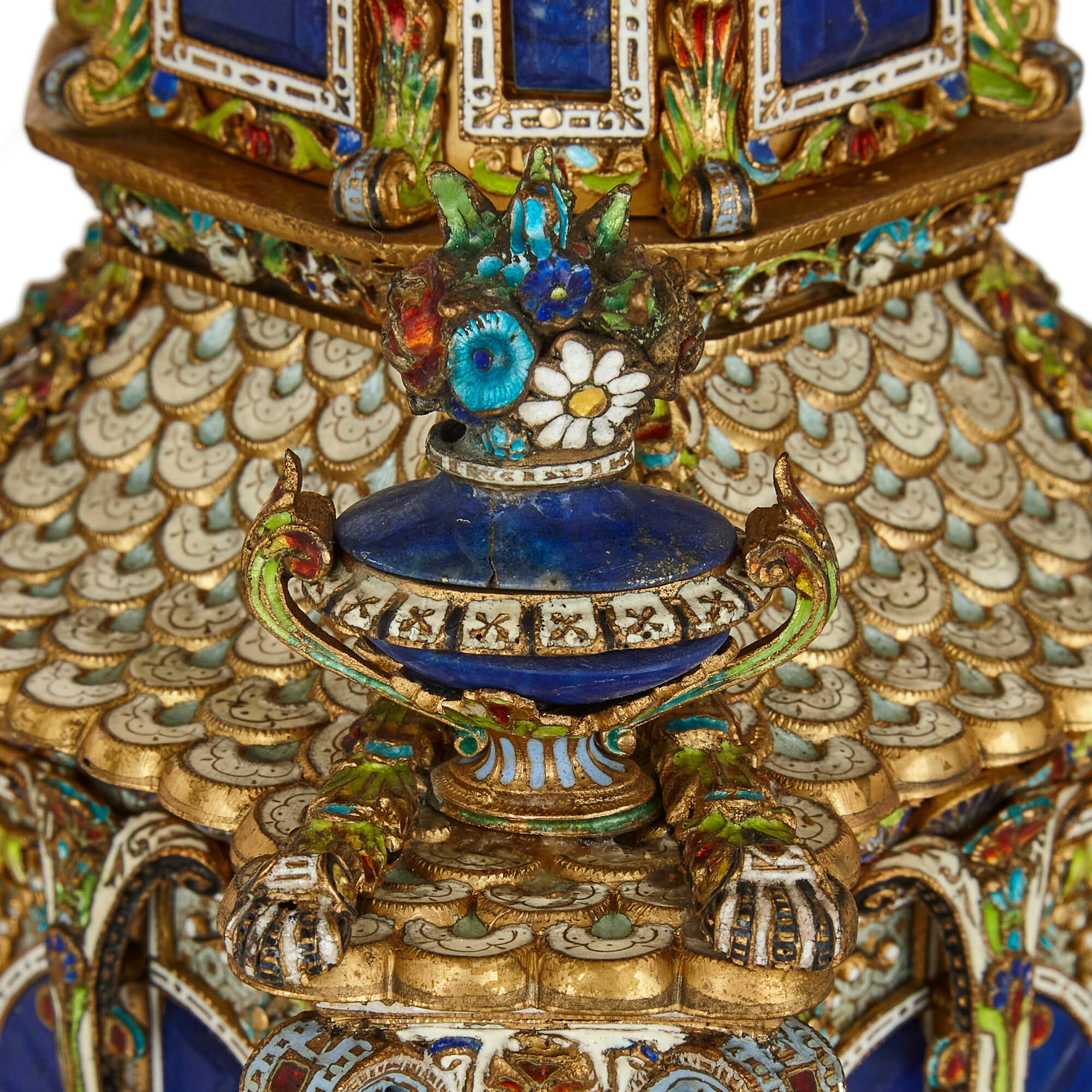This outstanding and very important three-piece clock set is an extraordinary example of late 19th century Austrian craftsmanship. The very large design is inspired by numerous cultures, such as Chinese, Turkish and Hungarian, creating an elegant conglomeration of styles and designs.
The clock is of a tiered pagoda shape, a clear Chinese influence in its design. It is surmounted by a silver-gilt and enamel eagle depicted in mid-flight standing on a lapis lazuli ball. The animal is most likely a reference to Turul, a mythological bird of prey which is a national symbol of Hungarians. The eagle is also popular in Turkish traditions.
Below the eagle, in a canopy raised on four vibrant lapis lazuli pillars, hangs a pair of silver gilt bells which are connected to the clock mechanism below. The bells are masterfully carved in acanthus leaf shapes and other foliate motifs, the artist most likely gaining inspiration from the works of classical Greece and Rome.
A clock is presented on all four sides of the piece, a very unusual and rare feature on clocks of this type. The inclusion of several clocks is a testament to the very high quality and well-thought-out design. It also signals that this clock set is aimed to be a centrepiece, viewed from all sides. The dial includes twelve numbers filled in black enamel with a gold outline. Each one is surrounded by a white circular border, making them easier to read. The minute hands have been expertly cast in the form of a moon while the hour hands are in the shape of a sun, representing the light and dark sides of one’s existence. The dials are decorated with complex patterns using the champlevé enamel technique, whereby metal is carved and filled with enamel. This technique has also been used throughout other parts of the clock set, such as the clock surround or the colourful patterns on various parts of the three pieces. All clocks are covered by a glass door hanging on a silver-gilt hinge.
Between each of the four clocks, female figures are applied, sitting on the four corners of the pagoda. Each figure is depicted in a different pose, for example, one is sitting with her legs crossed, holding a sickle and wheat (possibly symbolising harvest) while another is holding a bouquet. The females are dressed in various clothing, some with classical Greek and Turkish influences. The larger panels around the clocks and behind the figures are mounted with panels of bright, rich, ultramarine lapis lazuli. The naturally occurring patterns on this semi-precious stone add further interest to the overall design.
The third level of the pagoda, like all other levels, is topped by an intricate roof covered in a geometrical pattern and further silver-gilt as well as champlevé enamel attention-grabbing ornamentation. The four larger panels of similar size as the clock panels above, are adorned with silver-gilt, lapis lazuli and champlevé enamel illustrations. The panels most likely depict the mythological figures of Horae, the Greek goddess of seasons, the sides representing summer, spring, winter, and autumn. The panels are surrounded by two and three-dimensional champlevé enamel and silver gilt mounts, some in the shape of acanthus leaves. The four corners are supported by Corinthian columns, emphasizing the influence of the heritage of classical Greece and Rome. Vivid green, blue, and cream detailing adorn the acanthus leaf-shaped top.
The clock stands on a base with additional lapis lazuli panels framed in cream and silver borders. The carefully carved and cast silver gilt panels are decorated with numerous patterns and champlevé enamel ornamentation in flower forms and female masks designs. Some of the carved silver gilt ‘pits’ are filled with multiple colours of enamel creating a gradual colour change. This required the highest skill and added to the grandiose visual impact of the pieces.
The tiered pagoda-shaped clock is flanked by two candelabra, richly decorated in a similar manner. Each one comprises a single column, its appearance resembling the largest level of the large clock. Four angular branches grow out of the central column, each one topped by candle holders and drip pans. A longer column stands proud in the middle from which another candle holder and drip pan emerge. Like the clock, every layer and tier of the pagoda structures are adorned with a plethora of enamel embellishments in a host of colours, balancing the predominant tones of blue and gold with touches of orange, red, and green. Various illustrations are crafted on all sides of both candelabra, framed in a very similar way to the illustrations of the four seasons on the clock. For example, a globe with a telescope is crafted on one side whilst a painter’s palette is depicted on another. Floral motifs predominate the design of the candelabra with four vases full of flowers, such as daisies, standing on the four corners. The small vases too have been carved from lapis lazuli, a task only the most skilled craftsmen could do.
The set comes with original leather, velvet-lined fitted travel cases, adding yet another important feature to these exceptional pieces. Each case includes metal handles, enabling easy transport of the two candelabra and the clock.
This magnificent clock set was most likely gifted to the Tsar of Russia by the Austrio-Hungarian Royal family. Such provenance gives it an ever more important mark of quality and excellence.
In style, the clock set is like the work of Karl Rössler, a renowned Austrian artist. His pieces are known for the expert use of the champlevé enamelling technique as well as the proficient use of lapis lazuli and silver. Hermann Böhm, another Austrian artist of the late 19th century too produced pieces of this type.
The numerous influences, techniques, colours, and shapes employed, the artistry behind its design and make, as well as its royal provenance make this outstanding clock set a once-in-a-lifetime and museum-worthy piece of horological and decorative arts history.
Clock: Height 91cm, width 37cm, depth 37cm
Candelabra: Height 64cm, width 24cm, depth 24cm
Clock case: Height 97cm, width 44cm, depth 41cm
Candelabra case: 67cm, width 27cm, depth 27cm





